A long day, a call at 4 a.m. and up to the bridge by 4:30; we are 6 miles from the breakwaters of Cristobal, at the north entrance to the Panama Canal. The radios are constantly busy, vessels calling in for orders, others reporting positions.
We turn onto a southerly heading, aiming for the entrance between the red and green breakwater lights; there’s a strong current setting us east and the Officer of the watch has to allow 8⁰ of set in order to counter it.
Our orders are to be at the breakwater entrance at 5 a.m., we pass through them at 4:58, reducing speed sufficiently to allow agents, officials and pilot to board all the while continuing our route down the channel.
The officials carry out inspections, check manifests and declarations, eventually the issue our certificate of Transit, we can continue southwards, phew…..
The pilot meanwhile has come to the bridge and I have familiarised him with the instrumentation, the Amsterdam’s dimensions and her handling characteristics. We come to the agreement that ship’s staff, (me and 2nd-in-command, Friso), will take her into and out of the locks and when the locos are hooked on, he will take us into the final part of the chamber; he is pleased, this is going to work well.
The Canal, between entrances is 51 miles in length and has three sets of locks; Gatun, Pedro Miguel and Miraflores. Gatun has a flight of 3 locks and takes us ‘up’ approximately 80ft, or 26m. From here one enters Gatun Lake to Gamboa, 32 miles and then into the Culebra cut, this is 8 miles long and 150m wide, it can only be transited ‘one way’ at a time, so north and southbound vessels are timed in order that either all north or south have cleared it, prior to the ‘other way’ entering.
The Cut takes us to Pedro Miguel locks, which lower us 28ft, 9.4m into another small lake and thence to Miraflores locks, which lowers us the last 50 feet, 16m to sea level.
Going into Gatun, we are followed by the ‘Zuiderdam’, another of our ships; she is going to transit Gatun and then anchor in Gatun Lake, her guests then being transferred ashore on tours before she leaves and again, out of Gatun once more and back into the Caribbean.
As we approach Gatun, the modus operandi is the same as all the locks we will transit; as near as possible, without touching, (that’s a matter of pride), to the long centre wall, on this the locos wait. Lines are thrown, locos hooked on as the ship moves along and eventually, after the bow is well into the chamber, 3 each side are fast and the locos, advised by the pilot, take us in.
As we leave Gatun locks, we are told that some northbound ships are behind schedule and we will therefore have to lose time, we cannot enter Culebra Cut until they’re clear. So we do a fly-by of the construction of the new Gatun lock, a massive undertaking and by all accounts, well over schedule and budget, (of course).
Then slow-steam across Gatun Lake and its winding channels, past Balboa and into the Cut, it is here that the hardest, most gruelling work was done when the Canal was being constructed. Under the Centennial Bridge and, over 6 hours after leaving Gatun, Pedro Miguel beckons.
It is ‘Martyrs’ day in Panama, a public holiday and I have never seen so many people in the Visitors centre, watching us pass, it was packed and of course, much waving to and fro from us to them and back.
Once out of Pedro Miguel it’s a short ‘hop’ to Miraflores and the last flight that will take us down to sea-level, once through and therefore into the Pacific, we pass Panama port, then under the Bridge of the Americas. While we do so, officials and mooring linesmen disembark, our photographers, who have been recording our progress from ashore, embark. Finally, our pilot leaves us and we are on our own once more, heading towards Ecuador, Manta to be exact, where we arrive on Saturday morning.
The passage has taken us exactly 12 hours, breakwater at Cristobal to the sea buoy off Flamenco. We are tired, it has been a long day, nevertheless it has been successful, the guests enjoyed it immensely, (if one doesn’t include the torrential downpour in Pedro Miguel locks); the paint on our hull hasn’t a scratch on it and the team worked diligently, what more could one ask for?


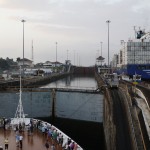
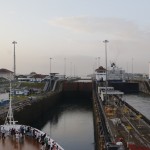
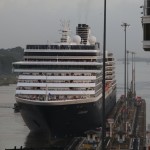

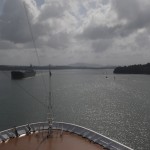
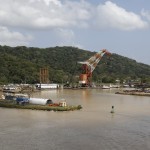
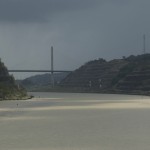
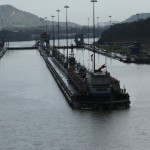
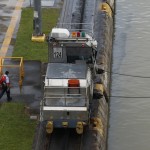
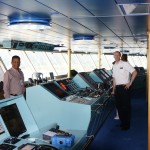

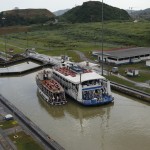
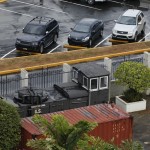
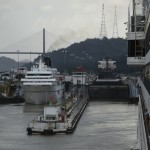
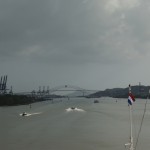
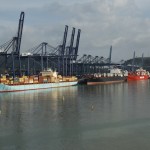

Very descriptive nautical explanation of the transit. I appreciated it, as I didn’t have that available on QE last January. Good for you to catch a photo of the old loco on the side rail. Maybe we’ll see it next year together.
It really is a wonder of the world, as is human skill to make it all operate with precision.
We are looking forward to doing the Panama transit. Great photos.